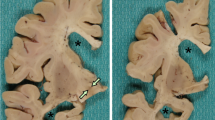Abstract
A Caucasian female who was noted to be mildly microcephalic at birth was diagnosed as having cerebral palsy at the age of 1 year. Her development was delayed and she never walked or talked. She appeared relatively stable neurologically until the age of 17 years when she had an illness with fever thought to be due to a virus. She was noted to deteriorate from this time on until her death at the age of 19 years. Autopsy revealed intranuclear and cytoplasmic inclusions widespread throughout the brain and visceral organs. There was no evidence of inflammation. Immunohistochemistry revealed strong immunoreactivity for tau protein and neurofilament protein. Electron microscopy revealed the inclusions to be composed of homogeneous finely granular material. Scattered with the granular material in the cytoplasmic bodies were crystalline structures with a honeycomb appearance. The possibility of these changes representing an old viral infection or a primary metabolic disorder are discussed.
Similar content being viewed by others
References
Bancher C, Lassmann H, Budka H, Grunde-Iqbal K, Iqbal K, Wiche G, Seitelberger F, Wisniewski HM (1987) Neurofibrillary tangles in Alzheimer's disease and progressive supranuclear palsy: antigenic similarities and differences. Acta Neuropathol (Berl) 74: 39–46
Defossez A, Beauvillain JC, Delacourte A, Mazzuca M (1988) Alzheimer's disease: a new evidence for common epitopes between microtubule-associated protein tau and paired helical filaments (PHF). Demonstration at the electron microscope level by a double immunogold labelling. Virchows Arch [A] 413: 141–145
Funata N, Maeda Y, Koike M, Yano Y, Kaseda M, Muro T, Okeda R, Iwata M, Yokoji M (1990) Neuronal intranuclear hyaline inclusion disease: report of a case and review of the literature. Clin Neuropathol 9: 89–96
Gambetti P (1993) Neuronal proteins: basic and applied aspects. Brain Pathol 3: 27–38
Garen PD, Powers JM, Young GF, Lee V (1986) Neuronal intranuclear hyaline inclusion disease in a nine-year old. Acta Neuropathol (Berl) 70: 327–332
Goutieres F, Mikol J, Aicardi J (1990) Neuronal intranuclear inclusion disease in a child: diagnosis by rectal biopsy. Ann Neurol 27: 103–106
Haltia M, Somer H, Palo J, Johnson WG (1949) Neuronal intranuclear inclusion disease in identical twins. Ann Neurol 15: 316–321
Hirano A, Zimmerman HM (1970) Some effects of vinblastine implantation in the cerebral white matter. Lab Invest 23: 358–367
Janota I (1979) Widespread intranuclear neuronal corpuscles (Marinesco bodies) associated with a familial spinal degeneration with cranial and peripheral nerve involvement. Neuropathol Appl Neurobiol 5: 311–317
Katsuragi S, Eto K, Takeya M (1981) One autopsy case presenting a variety of neurological disorders such as oculogyric crises and kinesia paradoxale in conjunction with numerous neuronal intranuclear eosinophilic inclusions (abstract, in Japanese). Neuropathology (Tokyo) 2: 63
Kosik KS (1993) The molecular and cellular biology of tau. Brain Pathol 3: 39–43
Lee G (1990) Tau protein: an update on structure and function. Cell Motil Cytoskeleton 15: 199–203
Lindenberg R, Rubinstein LJ, Herman MM, Hydon GB (1968) A light and electron microscopy study of an unusual widespread nuclear inclusion body disease. Acta Neuropathol (Berl) 10: 54–73
Michaud J, Gilbert JJ (1981) Multiple system atrophy with neuronal intranuclear hyaline inclusions: report of a case with light and electron microscopic studies. Acta Neuropathol (Berl) 54: 113–119
Munoz-Garcia D, Ludwín SK (1986) Adult-onset neuronal intranuclear hyaline inclusion disease. Neurology 36: 785–790
Nixon RA (1993) The regulation of neurofilament protein dynamics by phosphorylation: clues to neurofibrillary pathobiology. Brain Pathol 3: 29–38
Oyer CE, Cortez S, OShea P, Popovic M (1991) Cardiomyopathy and myocyte intranuclear inclusions in neuronal intranuclear inclusion disease: a case report. Hum Pathol 22: 722–724
Palo J, Haltia M, Carpenter S, Karpati G, Mushynski W (1984) Neurofilament subunit-related proteins in neuronal intranuclear inclusions. Ann Neurol 15: 322–328
Parker JC (1983) Sporadic spinocerebellar degeneration associated with intranuclear neuronal inclusions and arteriosclerotic heart disease. J Neuropathol Exp Neurol 42: 352
Parker JC Jr, Dyer ML, Paulsen WA (1987) Neuronal intranuclear hyaline inclusion disease associated with premature coronary artherosclerosis. J Clin Neuroopthalmol 7: 244–249
Patel H, Norman MG, Perry TL, Berry KE (1985) Multiple system atrophy with neuronal intranuclear hyaline inclusions: report of a case and review of the literature. J Neurol Sci 67: 57–65
Schuffler MD, Bird TD, Sumi SM, Cook A (1978) A familial neuronal disease presenting as intestinal pseudo-obstruction. Gastroenterology 75: 889–898
Soffer D (1985) Neuronal intranuclear hyaline inclusion disease presenting as Friedreich's ataxia. Acta Neuropathol (Berl) 65: 322–329
Sung JH (1980) Light, fluorescence and electron microscopic features of neuronal intranuclear hyaline inclusions associated with multisystem atrophy. Acta Neuropathol (Berl) 50: 115–120
Sung JH, Ramirez-Lassepas M, Mastri AR, Larkin SM (1980) An unusual degenerative disorder of neurons associated with a novel intranuclear hyaline inclusion (neuronal intranuclear hyaline inclusion disease). J Neuropathol Exp Neurol 39: 107–130
Tateishi J, Nagara H, Ohta M, Matsumoto T, Fukunaga H, Shida K (1984) Intranuclear inclusions in muscle, nervous tissue, and adrenal gland. Acta Neuropathol (Berl) 63: 24–32
Trojanowski JQ, Schmidt ML, Shin R-W, Bramblett GT, Rao D, Lee VM-Y (1993) Altered Tau and Neurofilament Proteins in Neurodegenerative diseases: Diagnostic Implications for Alzheimer's disease and Lewy Body Dementias. Brain Pathol 3: 45–54
Waggener JD, Beggs J, Sidell AD (1972) Virus-like filaments in juvenile parkinsonism. J Neuropathol Exp Neurol 31: 187
Author information
Authors and Affiliations
Rights and permissions
About this article
Cite this article
Ruszkiewics, A., Opeskin, K., Anderson, R.M.D. et al. Generalised nuclear and cytoplasmic inclusion disease: a rare case investigated by microscopy and immunohistochemistry. Acta Neuropathol 87, 648–654 (1994). https://doi.org/10.1007/BF00293327
Received:
Accepted:
Issue Date:
DOI: https://doi.org/10.1007/BF00293327




